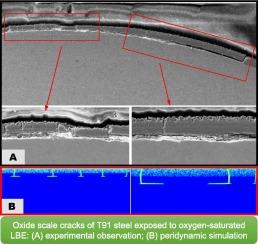Thermally-induced fracture in the oxide scale of T91 ferritic/martensitic steel after exposure to oxygen-saturated liquid lead–bismuth eutectic
Abstract
Ensuring the continuity and stability of the oxide scale to separate T91 steel from lead-bismuth eutectic (LBE) is an effective method for limiting corrosion in the lead-based fast reactor system. In this study, we specifically investigated the impact of cooling thermal stress on the stability and damage of the oxide scales of T91 steel when exposed to oxygen-saturated liquid lead–bismuth eutectic at high temperatures. A corrosion test was conducted on T91 steels exposed to stagnant oxygen-saturated LBE at 500 °C. Experimental results indicated that oxide damage exists without any external force, including interface cracks and through-scale cracks perpendicular to the interface. We developed a three-layer peridynamic model of T91-(Fe,Cr)3O4-Fe3O4 to simulate the deformation and failure of oxides under a cooling process from high temperature to room temperature. The simulation results show that a temperature drop of about 200 °C from 500 °C can cause through-oxide cracks in the oxide scale, and subsequent cooling can lead to the propagation of interfacial cracks. Additional modifications were introduced in the model to account for the porosity of the oxide scale. Parametric investigations illustrate the effects of oxide scale thickness and porosity on the resulting crack patterns.


 求助内容:
求助内容: 应助结果提醒方式:
应助结果提醒方式:


